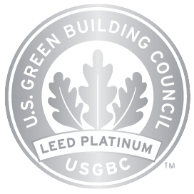Just about every city dweller knows that light pollution in NYC makes urban stargazing almost impossible. While the NYC night sky is equally unamenable to this activity, SUMMIT One Vanderbilt allows guests to transcend this limitation by bringing them closer — literally — to the stars.
One Vanderbilt’s towering elevation makes SUMMIT a unique vantage point for exploring the cosmos without traveling to a remote, rural location. When you’re 1,100 feet above the grid of city streets, you can see stars, planets, and other celestial bodies that are generally obscure or invisible from the ground. This view allows locals and visitors to tap into their “inner astronomer” and better appreciate the magic of the NYC night sky.
Indeed, the concept of engaging in astronomy in NYC’s heart has intrigued people since SUMMIT opened its doors. In some cases, guests have accidentally discovered that SUMMIT is an excellent astronomy observatory in NYC. They bought tickets for the evening and realized that being so high up alleviated some of the impacts of street-level light and air pollution. In other cases, SUMMIT guests have deliberately chosen the space as a location to stargaze due to its 360-degree views and accessible location.
Regardless of why nighttime observers have come to SUMMIT, they’re typically surprised at how much of the New York night sky they can take in. It’s a memorable, convenient stargazing experience that urban dwellers usually have to leave the city for.
You may have already tried looking up to see a meteor shower or the North Star from Central Park or outside of the Metropolitan Museum of Art. If so, you’ve noticed that engaging in astronomy events in NYC is inherently challenging. There are several reasons for this; however, by observing the New York City night sky from the decks at SUMMIT, these challenges can be partly overcome.
First is the persistent light pollution, as mentioned above. Called “skyglow,” this pollution can extend for miles and affect sites at low and high altitudes. SUMMIT’s place in the clouds tempers skyglow quite noticeably. You’ll see a big difference in images taken looking up from the ground versus looking up from one of SUMMIT’s three levels atop a skyscraper.
The second contributor to stargazing in heavily populated areas like NYC is infrastructure. With so many buildings and bright signs, cities are designed to give something other than unfettered views of the sky. On the contrary, they’re engineered to draw the eye toward the street and what’s happening immediately in front of the viewer.
Pollution is another reason city residents and tourists can only sometimes get a good view of the moon or brightest stars and planets. When combined with weather conditions like cloud cover and fog, visibility from the ground tends to be iffy at best.
Fortunately, this doesn’t affect the celestial view at SUMMIT. As one of the tallest skyscrapers in the world, One Vanderbilt offers an advantageous place for urban stargazing.
Do you like the idea of being able to stargaze in NYC with fewer obstructions? Try some of these ideas to turn an evening visit to SUMMIT into an astronomy session:
![]() Buy tickets when SUMMIT hosts special astronomy events in NYC.
Buy tickets when SUMMIT hosts special astronomy events in NYC.
SUMMIT regularly hosts programs like its popular New York Astronomy Nights with the Amateur Astronomers Association. These NYC astronomy events allow visitors to indulge in stargazing sessions and learn from expert astronomers, who are invited to help point out constellations, planets, and other cosmic objects. Plus, SUMMIT provides modern telescopes with filters and features to produce high-quality optics.
Attending these sessions can mean the difference between experiencing astrological phenomena and reading about them later. For example, in 2022 alone, Saturn, Jupiter, the full moon, the double star Albireo, and the red giant Arcturus were all documented and captured between June and September from the SUMMIT astronomy observatory in NYC.
![]() Use the right apps.
Use the right apps.
SkyView, Star Chart, and the NASA app are just a few of the programs you can access right from your smartphone to enhance your view of the New York dark sky. Whether you want to know which constellations are where or have questions about certain celestial phenomena, astronomy apps can provide you with the information you’re looking for.
Some can even help you locate artificial satellites like Starlink and the International Space Station! If you’re interested in getting an unmatched view of these objects gliding across the night sky, you can use apps to determine when you should make your visit. There are few places on Earth where this technology can be viewed so easily with just the unaided human eye.
![]() Time your tickets to enjoy both the day and New York dark sky view.
Time your tickets to enjoy both the day and New York dark sky view.
A huge benefit of SUMMIT is its extensive hours of operation. As a result, guests can time their access to have a taste of both daytime and nighttime views. These dual perspectives give you the best of both worlds, allowing you to see the splendor of the city during the day and the brilliance of the stars at night.
City dwellers interested in urban stargazing from SUMMIT may want to purchase a ticket when pollution is low enough to permit maximum transparency.
![]() Allow yourself to enjoy the psychological and emotional elements.
Allow yourself to enjoy the psychological and emotional elements.
The emotional impact of an immersive space like SUMMIT is almost overwhelming. Being so far above the hustle and bustle of the city can elicit a sense of tranquil solitude. Even when the space is crowded, SUMMIT can inspire a wonderful sense of peace and calm — perfect for contemplative stargazing in the city.
The mere act of ascending a tall structure can create a psychological sense of “getting closer to the stars.” SUMMIT brings this sensation to fruition by enabling guests to observe the beauty of the New York City night sky surrounding them.
Stargazing and astronomy in NYC aren’t a fantasy — they’re happening all the time from the art installations, glass elevators, and other spaces at SUMMIT. All it takes to join the ranks of SUMMIT astronomers who have visually journeyed to the cosmos is an elevator ride up Rise.
| Hours — |
|
||||||||||||||||
| Address — | 45 E 42nd St, New York, NY 10017
Entrance located on the Main Concourse of Grand Central Terminal |
||||||||||||||||
| Connect — | |||||||||||||||||




© 2024 SL Green. All rights reserved.